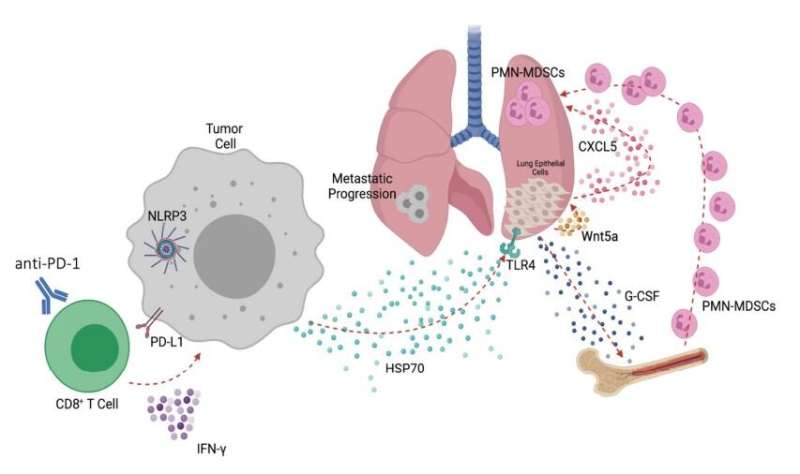Schematic of the tumor-intrinsic NLRP3-HSP70 signaling axis and its role in supporting metastatic progression in the lung in response to anti-PD-1 immunotherapy. Credit: B. Theivanthiran, et al., Science Translational Medicine (2022)
Duke Cancer Institute researchers have identified potential biomarkers that predict the likelihood for checkpoint inhibitor drugs to backfire, driving hyper-progression of melanoma cells instead of unleashing the immune system to fight them.
Prior studies have shown that cancer patients who develop hyper-progression while on checkpoint inhibitors have a median overall survival of 4.6 months compared to 7.6 months in patients without the complication. The phenomenon has been shown to occur in multiple tumor types, not only melanoma, but also head and neck, lung, and breast cancers.
The new study in mice and human tissue points to a strategy for inhibiting hyper-progression, potentially benefitting an estimated 10% of cancer patients who undergo this devastating complication from checkpoint inhibitor immunotherapies.
The study appears online Nov. 23 in the journal Science Translational Medicine.
"There is a continuum between resistance to immunotherapy and the development of a hyper-progressive state," said Brent Hanks, M.D., Ph.D., associate professor in the Department of Medicine at Duke University School of Medicine and senior author of the study.
"While hyper-progression occurs in a small percentage of cancer patients receiving checkpoint inhibitors, identifying the likelihood of this phenomenon has the potential to alter the clinical approach and avoid this complication," Hanks said.
Checkpoint inhibitors have been a cancer success story, but hyper-progression has been a troubling side effect in some patients. Hanks and colleague investigated the underlying mechanism for this process in melanoma, identifying a protein complex that is rooted in cancer tumors called the NLRP3 inflammasome.
Inflammasomes are danger sensors that typically help the immune system recognize foreign invaders. In certain cases, however, the researchers found that the NLRP3 inflammasome in tumors reacts to activated T-cell responses and triggers a cascade of events that results in resistance to the checkpoint inhibitors. The inflammasome process then goes into full-out protective mode where it builds an environment that helps cancer cells spread.
Once the process and key actors were identified, the researchers sought a way to identify which patients were at risk for developing hyper-progression prior to initiating checkpoint inhibitor immunotherapy.
Using tumor tissue samples from stage IV melanoma patients at Duke, the researchers found that high baseline concentrations of the molecules involved in the inflammasome process were associated with the development of disease hyper-progression and inferior survival.
"This work has led to the discovery of predictive biomarkers for checkpoint inhibitor immunotherapy resistance, including a blood-based biomarker and tumor tissue-based biomarker," Hanks said. "We will be testing these biomarkers for their ability to predict both disease resistance and disease hyper-progression in response to checkpoint inhibitor immunotherapy in a larger cohort of melanoma patients."
Hanks said his team is concurrently working with Duke colleagues, including April Salama, M.D., on a clinical trial using a therapy that inhibits the NLRP3 inflammasome among patients whose tumors have developed resistance to checkpoint inhibitor immunotherapies.
More information: Balamayooran Theivanthiran et al, Tumor-intrinsic NLRP3-HSP70-TLR4 Axis Drives Pre-Metastatic Niche Development and Hyperprogression During Anti-PD-1 Immunotherapy, Science Translational Medicine (2022). DOI: 10.1126/scitranslmed.abq7019. www.science.org/doi/10.1126/scitranslmed.abq7019
Journal information: Science Translational Medicine
Provided by Duke University Medical Center























